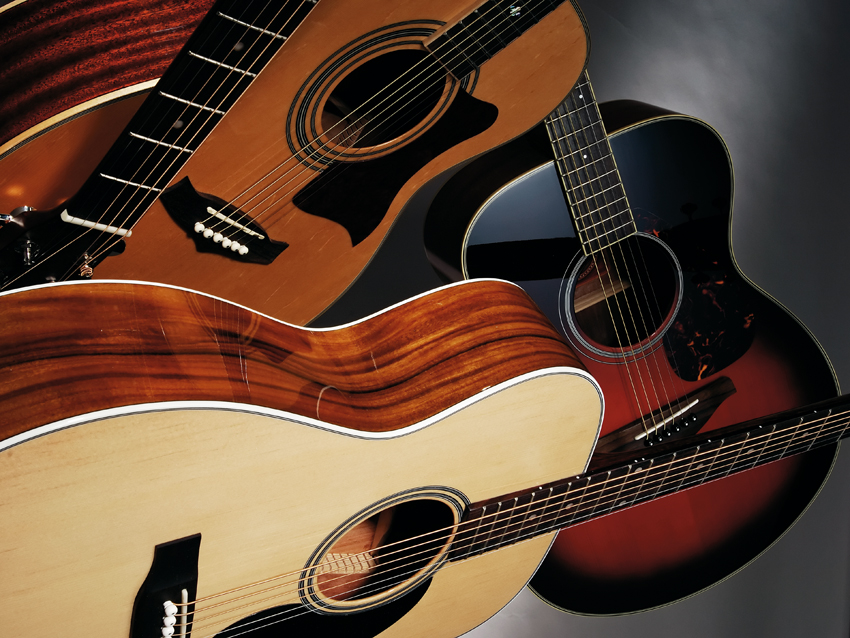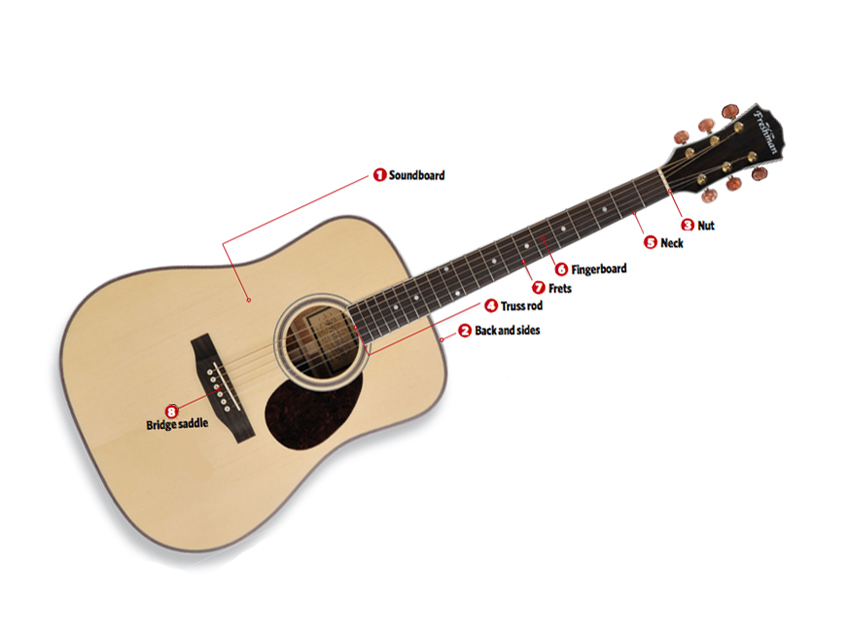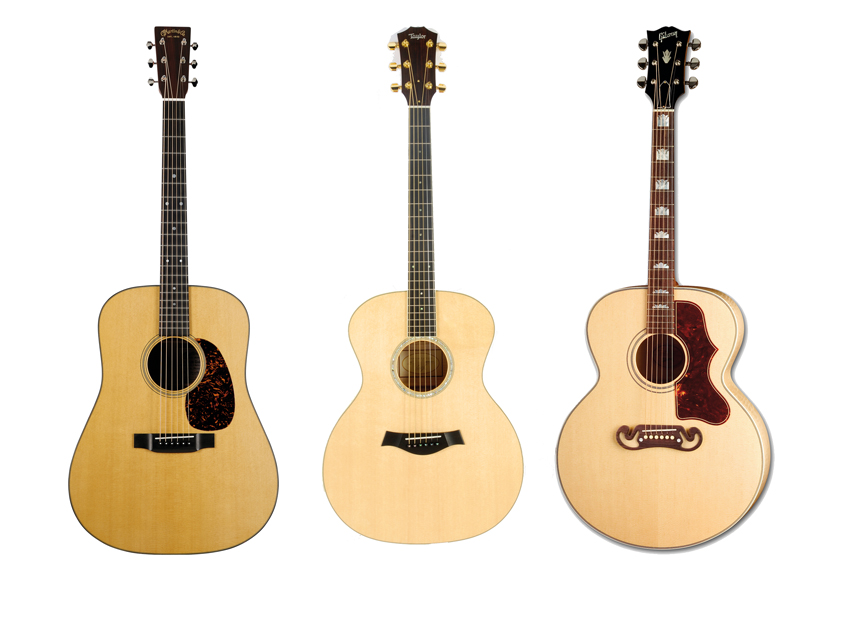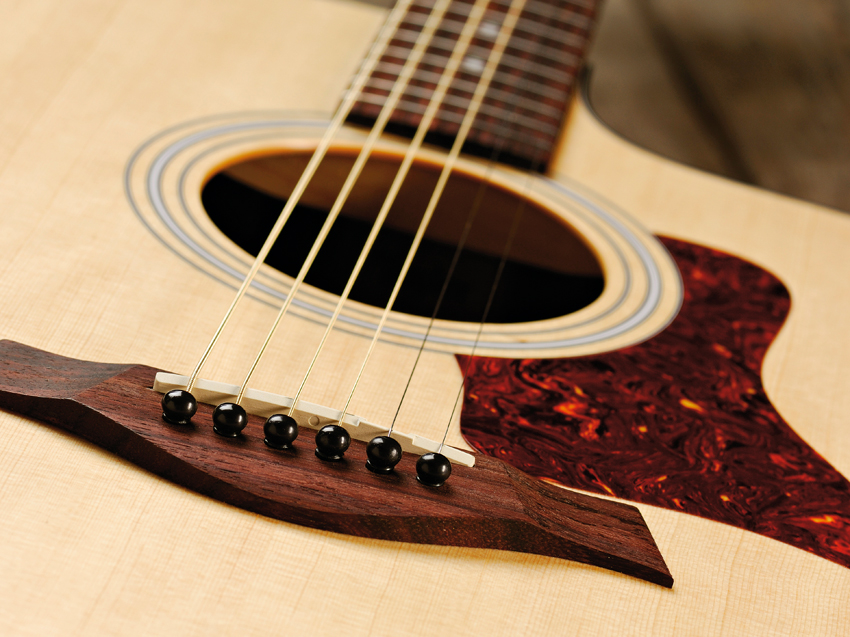The truth about acoustics
Know your acoustic onions

The truth about acoustics
The humble acoustic guitar is an essential part of every guitarist’s arsenal, but how many of us can actually explain the tonal differences between, say, mahogany and Engelmann spruce?
And how much impact do nut and saddle materials really have on a guitar’s tone? Here MusicRadar shines a light into the soundhole of acoustic myth and tells you what you should be looking (and listening) for in a steel-strung companion...

Acoustic parts
- Soundboard Think of this as the guitar’s speaker cone – the soundboard responds to the vibration of the strings and air movement. In general, the thinner the wood, the more responsive the soundboard is with these vibrations. But it needs to be thick enough to be strong.
- Backandsides These play a key part in your acoustic’s tone. Laminate guitars are made from multiple thin layers of wood bonded together with adhesive, while solid wood parts are made from a single ply. Laminate construction enhances strength, but doesn’t transfer the resonance as well as solid construction.
- Nut These can be made from various materials but all need to be hard enough to stop the strings wearing them through. The material choice has an influence on the tone.
- Trussrod Just like an electric guitar, the trussrod’s job on an acoustic is to counteract the tension of the strings on the neck – adjustment is made from either the headstock end or through the soundhole. The golden rule is to adjust with caution, and make small-increment turns.
- Neck The most common woods used for neck construction are mahogany and, more recently, Spanish cedar. The neck’s properties have an impact on tone because when you play, as much energy as possible needs to travel to the bridge to get those soundboard vibrations cooking. A very thin neck may be easier to play but your notes won’t sustain as strongly compared to a thicker neck. It’s a matter of compromise.
- Fingerboard The radius of a typical acoustic fingerboard usually measures between 15 and 18 inches – significantly flatter than most electrics. Most acoustic ’boards are made from rosewood or ebony: the latter wood is denser and tends to sound brighter.
- Frets The frets on an acoustic guitar tend to be thinner than those on an electric guitar, because acoustic playing technique usually involves far fewer string bends.
- Bridge saddle Like the nut, these tend to be made from plastic, bone or synthetic ivory (see the opposite page for more on the differences between them) and have an impact on the string vibrations and therefore sound of the guitar.

Acoustic FAQs
What shape guitar is best for me?
Personal preference and comfort are two crucial factors that make trying before you buy essential. But the characteristics related to certain acoustic shapes do make them better for some players than others.
A dreadnought is a good all-rounder; it’s the classic acoustic shape that’s suitable for flat-picking or strumming. Ditto the grand auditorium, with its wider lower body bout – a Martin signature model of this shape was famously used on Eric Clapton’s Unplugged performance and many other brands’ examples sport a cutaway.
The bigger-bodied super jumbo is better for strummers who want a big, booming rhythm sound, whereas the smaller-bodied parlour shape has been favoured by traditional blues and folk players who want midrange punch for fingerpicking styles.
Is it worth paying the extra for a guitar with a solid back and sides?
Usually, but it doesn’t cost a lot extra. Guitars with solid backs and sides take some time to mature but often end up having a warmer, more resonant sound than the laminated variety.
One of the greatest things about an acoustic guitar that you bond with as a player is that it could become a friend for life – whether as a songwriting tool, essential studio muse or just an accessible strummer for the living room. And the more inspiring it sounds for you, the better.
The advances in manufacturing in countries such as China mean solid-construction acoustics are nowhere near as expensive as they used to be.
With unplugged acoustic tone, we’re talking about the way that the air is being pushed around and the vibrations that movement creates. You want your guitar to enable rather than stifle the vibrations, and solid-wood back and sides are going to help push the sound out the soundhole.
Different tonewoods have different characteristics, too. Rosewood tends to be warmer sounding for back and sides with more tonal colour in the lower mids. Trebles also tend to have more presence compared to the main solid alternative, mahogany.
But mahogany has its own attractions. The best mahogany guitars have strong trebles with an almost chimey string separation when combined with a spruce top. With fewer midrange overtones, notes sound more direct than with rosewood.
There are other options available, including sapele – an African wood that’s similar to mahogany – and koa, which sits somewhere between the warmth of rosewood and the bright, punchy attack of maple.

Acoustic FAQs
A lot of acoustic guitar tops seem to be made from spruce – why’s that?
Spruce is ideal for tops because it has a good mix of strength, clarity and dynamics, and it looks good. There are a few different types. Sitka spruce is the most common, found in the US and Canada.
The lighter Engelmann spruce is found in the same part of the world and is seen as an upgrade from Sitka. German spruce is often used for classical guitars and is similar to Engelmann, while Adirondack is the most expensive – it responds well to hard playing while delivering balanced dynamics.
I heard a nut and bridge saddle made from bone is best... What say you?
Bone and synthetic bone (Graph Tech’s Tusq is an example of a man-made bone-replica) are good for transferring the sound of your strings. Cheap plastics won’t contribute much at all in comparison. On the whole, synthetic bone helps the tone sound a little brighter than the warmer bone. It’s also more resilient so will need replacing less frequently.
Some acoustics have the neck joining the body at a different fret – either the 12th or the 14th. Does it matter?
Yes, it does. Most acoustics you’ll come across will be the 14-fret join variety and 12-fret acoustics tend to be smaller-bodied guitars. The difference is about more than just how far down the dusty end of the neck you want to play.
The point where the neck heel is joined to the guitar’s body differs between them, and as a result this affects how rigid the neck is as well the position of the bridge on the soundboard.
These are two factors, among all the others, that affect the tone you can from an acoustic. Which leads us to a final point we can’t stress enough: with all these variables you need to get your paws on as many acoustics as possible and get a feel for them.
Take a guitar-playing friend to the music shop with you and play the guitars together for a live appreciation of their differences. Sooner or later, you’ll find your steel-strung soulmate.